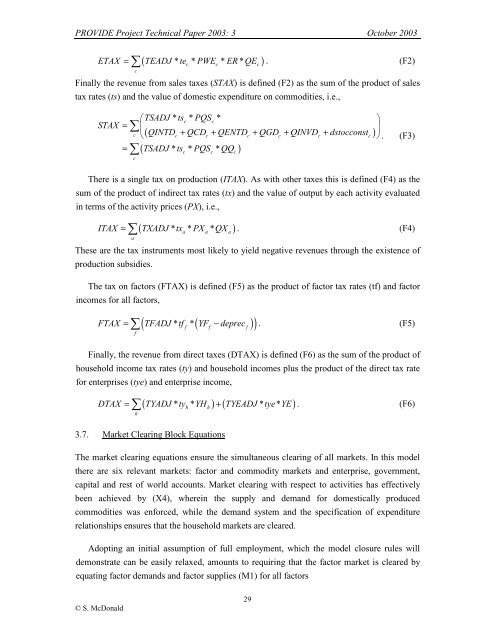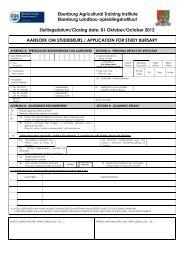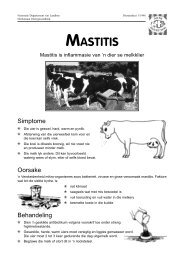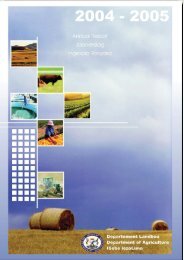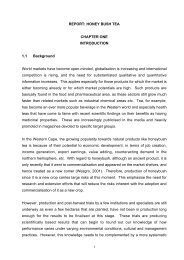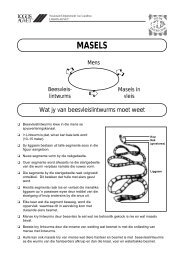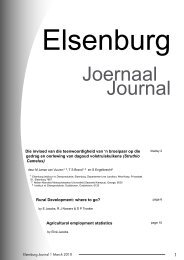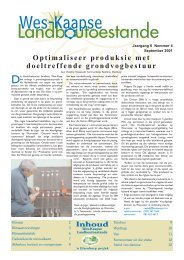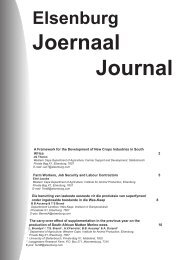The PROVIDE Project Standard Computable General Equilibrium ...
The PROVIDE Project Standard Computable General Equilibrium ...
The PROVIDE Project Standard Computable General Equilibrium ...
You also want an ePaper? Increase the reach of your titles
YUMPU automatically turns print PDFs into web optimized ePapers that Google loves.
<strong>PROVIDE</strong> <strong>Project</strong> Technical Paper 2003: 3 October 2003<br />
c<br />
( * * * * )<br />
ETAX = ∑ TEADJ te PWE ER QE . (F2)<br />
c c c<br />
Finally the revenue from sales taxes (STAX) is defined (F2) as the sum of the product of sales<br />
tax rates (ts) and the value of domestic expenditure on commodities, i.e.,<br />
STAX<br />
⎛TSADJ * tsc<br />
* PQSc<br />
*<br />
⎞<br />
= ∑⎜ ⎟<br />
c c c c c c c ⎠. (F3)<br />
=<br />
∑<br />
c<br />
⎝( QINTD + QCD + QENTD + QGD + QINVD + dstocconst )<br />
( TSADJ * ts * PQS * QQ )<br />
c c c<br />
<strong>The</strong>re is a single tax on production (ITAX). As with other taxes this is defined (F4) as the<br />
sum of the product of indirect tax rates (tx) and the value of output by each activity evaluated<br />
in terms of the activity prices (PX), i.e.,<br />
a<br />
( * * * )<br />
ITAX = ∑ TXADJ tx PX QX . (F4)<br />
a a a<br />
<strong>The</strong>se are the tax instruments most likely to yield negative revenues through the existence of<br />
production subsidies.<br />
<strong>The</strong> tax on factors (FTAX) is defined (F5) as the product of factor tax rates (tf) and factor<br />
incomes for all factors,<br />
f<br />
( * *( ))<br />
f f f<br />
FTAX = ∑ TFADJ tf YF −deprec<br />
. (F5)<br />
Finally, the revenue from direct taxes (DTAX) is defined (F6) as the sum of the product of<br />
household income tax rates (ty) and household incomes plus the product of the direct tax rate<br />
for enterprises (tye) and enterprise income,<br />
∑ ( *<br />
h* h) ( * * ). (F6)<br />
DTAX = TYADJ ty YH + TYEADJ tye YE<br />
h<br />
3.7. Market Clearing Block Equations<br />
<strong>The</strong> market clearing equations ensure the simultaneous clearing of all markets. In this model<br />
there are six relevant markets: factor and commodity markets and enterprise, government,<br />
capital and rest of world accounts. Market clearing with respect to activities has effectively<br />
been achieved by (X4), wherein the supply and demand for domestically produced<br />
commodities was enforced, while the demand system and the specification of expenditure<br />
relationships ensures that the household markets are cleared.<br />
Adopting an initial assumption of full employment, which the model closure rules will<br />
demonstrate can be easily relaxed, amounts to requiring that the factor market is cleared by<br />
equating factor demands and factor supplies (M1) for all factors<br />
© S. McDonald<br />
29


